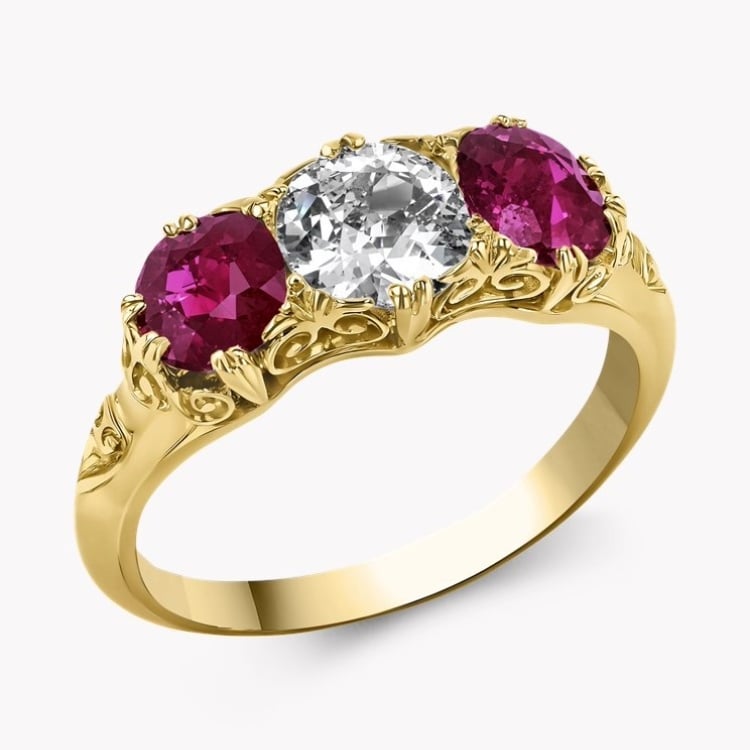Antique Gold Hallmarks: The Complete Guide
Antique gold jewellery offers a unique glimpse into history, with each piece telling its story through intricate designs and, importantly, its hallmarks. These official stamps confirm the gold's authenticity and purity and provide valuable insights into the item's age, origin, and maker.
In this comprehensive guide, we'll explore the world of antique gold hallmarks, offering expert advice on how to identify, date, and authenticate these marks and their significance in determining the value of these precious pieces. Whether you're a collector, enthusiast, or simply curious, understanding antique gold hallmarks is key to appreciating the true worth of your jewellery.
.jpg)
What is a Hallmark?
A hallmark is an official mark or series of marks stamped onto precious metals to certify their purity and authenticity. British hallmarking dates back to the 14th century and remains one of the oldest forms of consumer protection.
Historical Context of Hallmarking in Antique Gold
Hallmarking dates back over 700 years, originating in Europe to protect consumers by confirming gold's purity. In the UK, the system was established by the Goldsmiths' Company in the 14th century, where a series of marks were created to identify the maker, the purity of the metal, and the Assay Office that verified the quality.
Antique hallmarks are typically found on gold jewellery dating back to the Georgian (1714–1837), Victorian (1837–1901), Edwardian (1901–1910), and Art Deco (1920s–1930s) periods. Each era reflects distinct design trends, techniques, and hallmarking standards. Recognising these hallmarks can help date and identify an item accurately.
Delve deeper into these eras by exploring our collection of antique jewellery, where each piece tells a unique story.
Key Types of Hallmarks in Antique Gold
1.jpg)
Compulsory Marks
By law, British gold hallmarks must include specific marks to verify their authenticity. These include:
Millesimal Fineness Mark: A number representing gold purity (e.g., .375 for 9ct, .750 for 18ct).
Assay Office Mark: Identifies where the gold was tested.
Sponsor’s (Maker’s) Mark: The initials or symbol of the manufacturer or jeweller.
.jpg)
Purity Marks
One of the primary functions of a hallmark is to indicate the purity of the gold. In antique gold, you may encounter marks such as:
Carat System: Indicating the proportion of gold in a piece (e.g., 9ct, 12ct, 15ct, 18ct, 22ct).
Millesimal System: Commonly used in Europe, with numbers like 375 (for 9-carat) or 750 (for 18-carat).
Standard Mark: This is a key part of the purity mark system. The standard mark indicates the precise purity of the gold, often represented as a number (such as 375 or 750). It provides consumers with assurance that the gold is of the stated quality.
These marks often appear alongside assay office stamps or makers' marks.

Modern Assay Office Marks
Assay Office Marks
The Assay Office mark indicates where a piece of metal was tested for purity. In modern-day Britain, there are four main assay offices:
London – represented by a leopard’s head
Birmingham – represented by a horizontal anchor
Sheffield – represented by a Tudor rose
Edinburgh – represented by a castle
In the 18th and 19th centuries, other notable assay offices included Chester, Glasgow, Exeter, and York.
Over time, the original assay marks have evolved. Initially, the present-day London leopard mark was depicted as a lion's head with a full mane and crown. However, these details were simplified over the years, resulting in variations such as a lion's head without a crown, a lion's head crowned but without a mane, and a lion's head lacking both crown and mane. In 1922, the lion was officially replaced by a leopard.
These marks are often accompanied by the date letter, which indicates the year the piece was assayed.
Date Letter Mark
Date stamps indicate the year an item was assayed, changing annually since 1570.
Example:
A = 1900
B = 1901
C = 1902, and so on.
Traditional Fineness Mark
Before the introduction of the millesimal system, antique gold was marked with symbols, such as a crown, to indicate the purity of older pieces. This was followed by the carat system, which measures gold purity in parts out of 24. For example, 9ct signifies nine parts of gold per 24, while .375 represents 375 parts per thousand. Gold hallmarking, as we recognise it today, began in the 14th century.
Convention Hallmarks
Antique gold refers to items that are over 100 years old and therefore will not carry the Convention Hallmark. Since the 1970s, the International Convention on Hallmarks has allowed recognised marks to be accepted across member countries, facilitating easier trade and verification of authenticity. Some antique pieces may feature both British and foreign hallmarks.
.jpg)
French 0.55ct Sapphire, Ruby and Diamond Cluster Ring in 18ct Yellow Gold from the Belle Époque period
Common Marks on French Jewellery
Antique French jewellery is highly collectable for its exceptional craftsmanship, historical significance, and timeless beauty. It represents a legacy of artistic talent and connects to important periods in French history. The meticulous techniques employed by French jewellers, along with the enduring appeal of their designs, make these pieces highly sought after by both collectors and enthusiasts.
French hallmarks, known as "poinçons," are a specific series of symbols and numbers that appear on antique jewellery. They indicate the type of metal, its purity, and sometimes the maker or assay office.
Common marks include:
An Eagle's Head represents gold; this could be of different standards, usually 18ct (750/1000).
An Owl is a French mark stamped on items imported into France.
A Scallop Shell indicates 14-carat gold (585/1000).
A Clover (Trèfle), which indicates 9-carat gold (375/1000).

Victorian 1.55ct Ruby and Diamond Three Stone Ring in 18ct Yellow Gold
How Antique Hallmarks Differ from Modern Hallmarks
Antique hallmarks often feature old-style fonts, elaborate symbols, or discontinued carat standards (e.g., 15ct, which was abolished in 1932).
Modern hallmarks follow the same principles but adhere to updated legal requirements and standardised marks.
Some antique gold may lack a hallmark due to wear or older regulations.
How to Identify an Antique Gold Hallmark
1. Locate the hallmark – Usually found inside rings, on clasps, or on the back of pendants.
2. Check for purity marks – Look for carat or millesimal numbers.
3. Identify the assay office – Compare symbols to official marks.
4. Look for a maker's mark – Initials or a unique stamp can provide provenance.
5. Use a date letter reference – Match the letter to the correct year.
While many antique gold hallmarks are easy to spot, identifying and verifying authenticity can be complex. If you're unsure about a piece, professional appraisal services can provide expert insight and confirmation.
The legacy of hallmarking in antique gold jewellery is a testament to centuries of craftsmanship, authenticity, and quality assurance. These intricate marks continue to be a valuable resource for identifying and verifying antique pieces, providing collectors and enthusiasts with essential clues about a jewellery item's history, purity, and provenance. By understanding and appreciating these hallmarks, you gain insight into the past and protect and enhance the value of your antique treasures for future generations.
Frequently Asked Questions
Below are the answers to our most commonly asked questions. Should you want to find out more please feel free to Contact Us and begin your Pragnell experience.
Collectable hallmark symbols may be sought after by enthusiasts. An item's provenance can also make it more collectable compared to similar pieces without hallmarks. Examples of rare marks include duty marks (used from 1784 to 1890), coronation marks, jubilee marks, and retired marks like 12ct and 15ct gold.
Antique CLP Page
Contact us